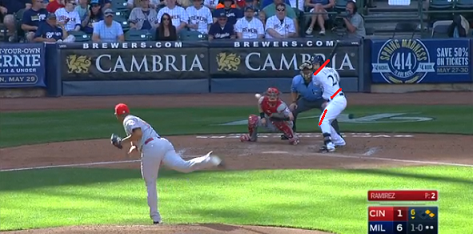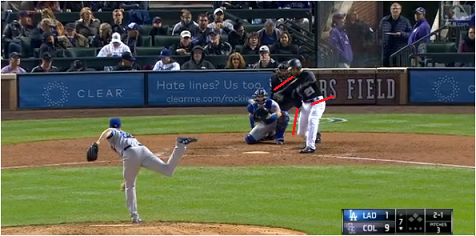Jonathan Lucroy Might Not Be Done
Let’s start off with a guessing game. Below are two players. Try to tell who they are.

So, who are they?
Maybe the title of this post helped you figure it out. They’re both Jonathan Lucroy. Player A is Lucroy in 2016, when he was worth more than four wins. Player B is him in 2017 when he was barely worth one win. But these two lines represent the same player in name only. In 2016 Lucroy was the most valuable catcher in the game. And then last year, he was the fourth-worst.
Moving down the chart above, one could reasonably tell Lucroy’s story. Maybe the difference on balls in play is what drove him from about 40% above league average at the plate to about 10% below league average. But that wasn’t just bad luck; his contact numbers probably justify the drop. Driving the ball with less authority means hitting more playable dinkers. That creates lower BABIP and wOBA. It’s also not going to help if you hit an additional 16% grounders from one year to the next, which Lucroy did, because, those playable dinkers are the worst playable dinkers a hitter could generate.
In some sense, catchers aren’t supposed to be as good as Lucroy has been in the past. Expecting him to stay that good forever would be silly. But so would expecting him to fall off the edge of a flat earth into the same relative nothingness as Martin Maldonado. Jeff Sullivan broke down Lucroy when he was traded to the Rockies last season and found that in addition to his offensive stats cratering, so had his previously excellent framing numbers. He went from being one of the game’s very best at stealing strikes to being one of its very worst. So maybe Father Time had simply claimed eminent domain instead of moving next door.
The numbers bear out Lucroy’s fall as much as numbers can. But the same thing that makes them so endearing — their blindness — sometimes means they still aren’t telling the whole story. Below are two gifs. On top is Lucroy as a Brewer in 2016, driving a JC Ramirez fastball up the middle. Below is Lucroy as a Rockie in 2017, pulling off of a Ross Stripling slider.


Above, the Angels defense was presumably playing at double play depths, making a play up the middle more accessible, if still difficult. Thought it was a grounder from Lucroy, it was a screamer, coming off the bat at 100.7 mph (he averaged 87.6 in 2016). Below, Lucroy forced Corey Seager to make a bit of a play, but Seager was able to because the ball only came off Lucroy’s bat at 88.4 mph (he only averaged 85.1 last season). Both pitches were in the middle third of the plate. The swings are similar enough. But check out the stills below as the ball arrives at the plate.e.

In this picture, from when he was still a Brewer, Lucroy is very much in control. He’s square, and his body is getting ready to move together. All the MSPaint lines are moving in the same direction, showing that his kinetic chain is tuned up. That basically means his big muscles were ready to transfer power to his little muscles. The next frame shows it stayed that way. The swing is coming from his center of mass. Sure, he grounded out, but he was together. Groundouts happen.

But look at this still, from when Lucroy was a Rockie last year, and good grief. His body is moving in so many directions it looks like it’s in a traffic jam. His hands are going down and away, his hips are pulling in the other direction, and his legs are digging directly ahead. The kinetic chain is nowhere to be found, and Lucroy’s one body is effectively acting in three independent manners. Doing that on a regular basis would go a long way toward explaining his sudden inability to drive the ball, and how he lost 2.5 mph of exit velocity on average per batted ball.
Lucroy’s legs being hurt, but not enough to sideline him to ensure they’re healed, could explain an inability to rely on his core to support his kinetic chain. However, per Statcast, his sprint times were nearly identical between 2016 and 2017. In fact, he was actually .2 seconds faster last year than the year before. But that’s only his legs. Maybe he had an issue with his core — a set of big muscles — that kept his swing from staying in sync and glove from reacting as well when framing.
Baseball Savant only has so much video to examine. Lucroy’s broken kinetic chain in 2017 appears to be pretty consistent, though. And sure, these were different pitches, from different pitchers, with presumably different camera angles. I can’t tell you the ball was at the exact same distance from Lucroy in each instance. But a nagging injury influencing a mechanical flaw isn’t entirely implausible, even if speculative.
If Lucroy can smooth out his mechanics and is even half of what he used to be, that’s still twice as much as he was last year. Or maybe he did just fall off a cliff. But at one year and 6.5 million, it’s easy to understand why the A’s would want to find out.
—
Mystery player data from FanGraphs. Gifs made with Giphy; videos from Statcast.
Tim Jackson is a writer and educator who loves pitching duels. Find him and all his baseball thoughts online at timjacksonwrites.com/baseball and @TimCertain.
It’s cool to see how his swing was different in each gif, and the lines drawn on the pictures really helped make that clear. Good work for sure.
Right? The visual made the data way more interesting for me when writing it up. I plan on using more of this kind of thing. Thanks for reading!
I also caught a quote by Lucroy from a Peter Gammons piece yesterday: “…my mechanics got out of whack, and I know it.” He’ll be one to watch early this season.
I’d be interested to look at wether his hitting and pitch framing have suffered in concert. From previous articles on his framing it has been identified that he doesn’t set up as low as he use to. Perhaps his lost flexibility (or whatever is causing his lethargy on defense) has also started to drag his hitting down. If I were to guess his hip flexors are probably in need of some serious work as they are integral in crouching and generating the initial burst in the hips for a swing. I do love the wild speculation.
I’m no doctor — I haven’t even stated at a Holiday Inn — but it would certainly be interesting to see if there’s a correlation between his defense, offense, and hip flexors. I wonder if we have the tools to do that.